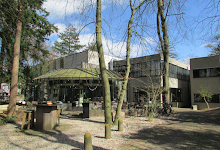Archive number: 119
Title:
Aya-yuppie-hippie-hee
Main
Album: Focus 9 (New Skin)
Track
number: 7
Genre:
Progressive Rock Instrumental
Studio:
Fieldwork Studios, Schoten, Belgium
Length:
05:15
Composer:
Bobby Jacobs and
Thijs van Leer
Musicians:
Thijs van Leer – Hammond organ, flute, voice, bird whistle; Niels van der Steenhoven – Guitars; Bobby Jacobs – Bass; Pierre van der Linden – Drums
Producer:
Bobby Jacobs and Thijs van Leer
Engineer:
Han Nuijten
Label:
Red Bullet
Date
of recording/release: Summer 2006
Alternative
version: None
Notes:
A traditional clay bird whistle is heard at the beginning of this
track which typically alternates between first a yearning theme on
guitar backed by the band (00:00-00:29) and a contrasting rock theme
introduced the first time by drums and consisting mainly of a four
note riff from the guitar backed firstly by harmonics and organ with
some great drumming from van der Linden (00:30-01:16). When the high
soaring guitar returns at 01:15-17 it leads into a twofold repetition
of the title – Aya Yuppie Hippie Hee – the vocals having an
effect on them (01:18-01:26). We then slip back into the rock theme
with the second guitar wailing much more this time (01:27-02:10)
before a repeated “Aya Yuppie” section (02:11-02:22) and the rock
theme again (02:23-02:44). There is then a break down into a quieter
and slower guitar section (02:45-02:54) that gives way to a three
note riff (02:55, 56) followed by a jazzy flute-led part
(02:57-03:29), van Leer breaking out vocally at 03:14 and other
points, ending with some glossolalic scat. At 03:30 we begin on an
increasingly wild guitar-led lead up to first the rock and then the
yearning themes which come in at 04:14-04:35 then 04:36-04:59 (listen
out for the bird whistle), the whole closing on one more brief
rendition of the rock theme with a sudden, decisive and unified stop
at 05:12 (the reverb lasting just a few seconds more).




















